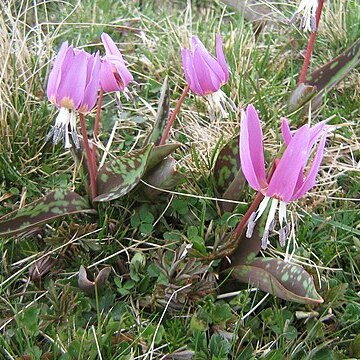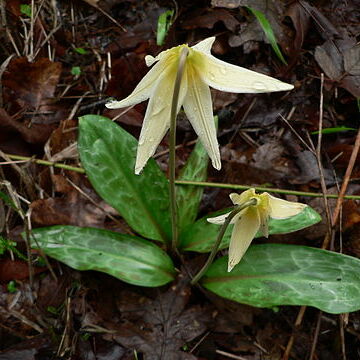Herbs, perennial, scapose, from ovate to elongate bulbs, sometimes with small, beadlike segments of short, persistent rhizome attached; several species producing additional bulbs as sessile bulbels or at the ends of slender stolons or vertical droppers, these species typically flowering more sparingly than those without extensive vegetative reproduction. Leaves 2 (1 in nonflowering plants), basal, ± petiolate; blade green or mottled with purple, brown, or white, lanceolate to ovate (wider if solitary), flat to folded, 6–60 cm, glaucous in a few species, glabrous, base narrowed gradually or abruptly to petiole, margins entire or sometimes wavy. Scape green or sometimes reddish, typically elongating in fruit. Inflorescences terminal, racemose, 1–10-flowered. Flowers showy, usually nodding, sometimes held laterally or erect; tepals 6 (as few as 4 in E. propullans), spreading to reflexed, distinct, similar, white, yellow, pink, or violet, often with basal zone of yellow or other colors, lanceolate to ovate, inner tepals auriculate at base in many species, auricles appressed to ovary and forming sac-or pocketlike hollows on adaxial surfaces; stamens 6; filaments generally slender; ovary superior; style 1, abruptly attached to ovary (or forming a beak in E. rostratum); stigma unlobed or 3-lobed, lobes recurved to erect. Fruits capsular, erect, obovoid to oblong, apex rounded, truncate, or umbilicate (beaked in E. rostratum), dehiscence loculicidal. Seeds brown, ± angular, ± ovoid. x = 11, 12.
More
Herbs perennial, bulbiferous. Bulb deep seated, usually cylindric or narrowly oblong; tunic membranous. Stem simple. Leaves 2, borne near middle of stem, apparently opposite, petiolate, unequal, usually ± reticulate veined. Inflorescence 1-to several flowered, racemose or umbellate; bracts usually absent. Flowers bisexual, nodding, rather large. Tepals 6, free, spreading, recurved, or reflexed. Stamens 6, inserted at base of tepals; filaments filiform to slightly flattened, usually unequal; anthers basifixed. Ovary 3-loculed; ovules several to numerous per locule. Style filiform or slightly thickened distally; stigma 3-lobed. Fruit a capsule, subglobose to ellipsoid, 3-angled, loculicidal. Seeds compressed or somewhat swollen.
Tep (4–)6, lanceolate, separate to the base but connivent, at anthesis spreading and usually eventually recurved; stamens 6; filaments elongate, flattened below; anthers linear-oblong, basifixed; ovules several to many; style slender below, usually thickened above to the 3 short stigmas; fr an obovoid to oblong loculicidal capsule; perennial from a deep solid corm, the slender stem about half subterranean; lvs borne near the middle of the stem and therefore appearing basal, usually mottled with brown, lanceolate to oblanceolate or elliptic. 15, all N. Amer. except E. dens-canis L., the European dog-tooth violet, with narrow, tapering, violet tep.


